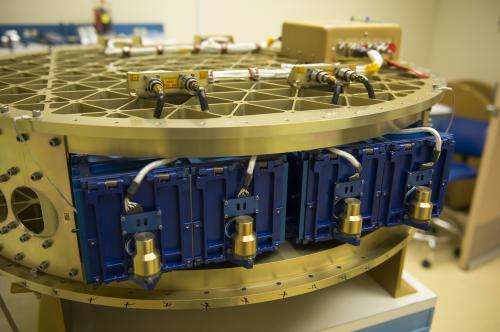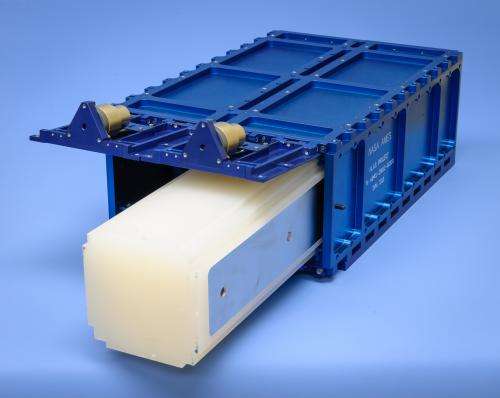NASA-built nanosatellite launch adapter system ready for flight

(Phys.org) —Nanosatellites now have their own mass transit to catch rides to space and perform experiments in microgravity. A new NASA-designed and developed satellite deployer, dubbed the Nano Launch Adapter System (NLAS), is scheduled to demonstrate the capability to launch a flock of satellites into space later this year.
Capable of carrying up to 24 nanosatellite units, or more than 100 pounds of secondary payloads into orbit, the deployer is complete and ready for flight. NLAS is designed to sit beneath a primary spacecraft and connect it to the upper stage of a rocket. Standing a mere ten inches tall, NLAS is short enough to squeeze various configurations of cubesats, such as 3-unit satellites that measure approximately 14 inches long, 4 inches wide and 4 inches high, or 6-unit satellites that measure approximately 14 inches long, 9 inches wide and 4 inches high.
Engineers expect that several NLAS could be stacked in a launch vehicle, allowing a single launch to bring dozens of small satellites to orbit. Once the primary spacecraft is safely delivered to orbit, NLAS deploys its payloads successively to their destinations, sometimes in a constellation.
"The launch adapter greatly enhances NASA's ability to rapidly deploy small low-cost satellites to space," said David Korsmeyer, director of engineering at NASA Ames Research Center at Moffett Field, Calif. "We expect this will improve NASA's opportunities to fly small satellite missions as secondary payloads and lead to greater opportunities for more complex and efficient spacecraft launches in the future."
This NLAS flight demonstration is expected to show the potential value of multiple, small satellites as tools for a wide array of scientific, commercial, and academic space research. Other goals of the project include reducing the cost and time required to integrate nanosatellites to rockets.

Each time a rocket launches, it must be painstakingly balanced using ballast – which can be sand, water or metal used as a balancing mechanism – to ensure its trajectory is accurate. Nanosatellites and their deployment systems also can act as ballasts during launches.
"Small spacecraft have the advantage of being able to share launches with other spacecraft, reducing the launch cost to the spacecraft developer team. This allows us to launch a number of these smallsats in support of NASA's space technology goals," said Bruce Yost, the program manager for the Small Spacecraft Technology Program at NASA Ames."
NLAS was designed and constructed by a team of experts from the Mission Design Division at Ames, commercial entities, and other government agencies. NASA Ames employees built the NLAS deployer using off-the-shelf components and specially crafted parts designed to standard dimensions for 1-, 3- and 6-unit nanosatellites launched from a variety of rockets, including Falcon 1 and Minotaur 1. NLAS is jointly funded by the Small Spacecraft Technology Program of the Space Technology Mission Directorate at NASA Headquarters in Washington and NASA Ames.
More information:
For more information about the Mission Design Division at NASA Ames, visit: www.nasa.gov/centers/ames/engi … isions/missiondesign
For more about information about NASA's Small Spacecraft Technology Program, visit: www.nasa.gov/smallsats
Provided by NASA

















